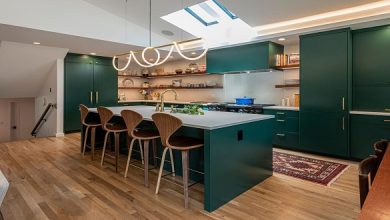The Pros and Cons Of Popular Window Styles

There are many factors to take into consideration when choosing windows Dublin for new or replacement. There are many factors to consider when choosing windows Dublin for replacement or new construction. Before you make any decisions, it is important to analyze the main operating styles of your windows. Each style has its advantages and disadvantages. You can visit expert windows. There are many window style variations. Some of them are adaptations of existing designs.
Many houses will have many window styles. Designers advise against mixing too many designs into one home. It can create a disjointed appearance. It’s likely that you will keep the same window design when replacing one, but you can replace all of them simultaneously to make a dramatic change. The architectural style of your house is important when choosing windows. Certain window types are more compatible with certain architectural styles.
These are common window styles
- Windows with two sashes
- Muntins can be double-hung
- Casement windows can be described as windows that open inwardly.
- Windows with awnings
- Windows that slide open
- Windows that were repaired
- Skylights and roof windows
- Window with a bay or bow
- Windows with a glass block
These window types are very popular. Here are some tips.
Windows with two panes
Even if this window design isn’t known by its official name, it is the most familiar. Double-hung windows have two large sashes, which are frame pieces that enclose glass panels. They glide along vertical rails. In older styles, weights are hidden behind the case mouldings to counterbalance the sashes. However, modern double-hung windows have springs that are hidden in the side tracks.
Double-Hung Windows are distinguished by their distinctive double-moving slash.
To provide ventilation, any sash can be moved up or down.
Uses
Double-hung windows are more common in homes that have traditional architecture, but they can also be found in modern-style residences. Double-hung windows can be found in traditional bungalow, farmhouse and rambler designs.
Pros
- A double-hung window offers the greatest advantage in cleaning. The sashes can move up and down, tilt in, or tilt out. Instead of climbing ladders or scaffolding, you can clean the windows’ outside from the inside.
- There are many manufacturers of double-hung windows so you have many options.
- Prices are usually low because of the wide availability of this style of window.
- Double-hung windows offer two additional benefits: ventilation and airflow management. For optimal ventilation, you can open the top and bottom sashes.
- Double-hungs can be opened and closed easily due to springs or weights.
- Double-hung windows that are energy efficient can reduce your heating and cooling costs.
- Because they are vertical tracks, dirt rarely fills them up.
- Double-hung windows make it easy to install window air conditioners. Because they can be kept safe and allow for easy removal, AC units can be safely removed.
- It is suitable for many settings.
- These windows are designed to reduce the risk of accidents because they do not open outwardly nor crank outwardly in high-traffic areas like patios, decks, or decks.
- Double-hung windows are well-known for their timeless appeal. Double-hung windows can be installed in any space or house. There are many styles, sizes, colors, and finishes available.
- A room that needs more ventilation.
Cons
- It’s really expensive.
- Over time, counterbalance springs or sash cords may wear out or become damaged. To keep these windows in top condition, they must be maintained on an ongoing basis.
- These windows are difficult to fix.
- This window style can be a danger to burglars if it has large holes.
- If they aren’t tinted, they will trap heat.
Warning
Double-hung windows that are low against a wall can create a large opening when the bottom sash opens. This can pose a danger for children. 1
Windows with one sash
The single-hung window can be used as an alternative to the double-hung windows.
Double-hung windows have two separate upper and lower sashes. Single-hung windows also have this feature. The only difference between a single-hung and a double-hung windows is that the upper sash stays in place while the lower sash can be moved.
While single-hung windows offer the same benefits and drawbacks as double-hung windows they also have some energy-saving benefits. They are generally considered a cheaper alternative to double-hung windows.
Two sashes are found in the hanging window.
A hanging window’s upper sash is fixed, but the bottom sash can be moved. It’s also known as a single-hung window.
To open the window, you must lift the bottom sash toward the top.
It is most common in new house constructions, apartment complexes, or office buildings.
The average market price of a single-hung window ranges between EUR100 to EUR300.
A single-hung window costs 20% more than a double-hung one. Maintenance is more costly for single-hung windows than double-hung windows.
Muntins on Double-Hung Windows
This basic double-hung window has a grid of vertical and horizontal muntins that divides larger sashes into smaller frames. In older windows or more expensive windows, the muntins might support small glass panels. However, modern muntin windows give the illusion of a grill made of wood or plastic that rests over a large pane of glass. Many double-hung windows have muntins as an optional feature. Muntins can be placed between large panes of glass in triple- or double-glazed windows to create the illusion of smaller panels.
Uses
A double-hung-with-muntin window is similar to a conventional double-hung window, but it has a little more traditional, ornate appearance that would be suited for colonial, Victorian, or other classic designs.
Pros
- There is also a room on the ground floor.
- A space that requires less ventilation
- The same as regular double-hung windows.
- Single-hung windows are easier to maintain than double-hung windows. This window may have fewer sashes which can lead to a higher price. There is also no extra glass to break.
- It retains its old-fashioned charm.
- Prices for single-hung windows can vary depending on their manufacturer. However, they are generally less expensive than double hung windows. In most cases, single-hung windows are up to 15% cheaper than double-hung windows.
Cons
- Cleaning professionals are required.
- The same as regular double-hung windows.
- Higher prices
- True muntin windows’ glass may become brittle over time. This can reduce the window’s energy efficiency.
- The airflow and ventilation are both reduced.
- Fake muntin grills are often cheap and can look inauthentic.
Windows with Casements
Casement windows open horizontally and have hinges at the top or bottom. The window’s one side is stationary while the other opens like a door. These windows are second only to double-hung ones.
A casement window has one or more hinges that attach it to the frame.
To provide total top-to-bottom airflow, it can be opened to either the left or right.
Uses
When properly positioned, casement windows can be a more modern look than double-hung windows. They may also be very effective in capturing and channelling cool breezes into your home.
Pros
- This design is great for modern and cottage homes.
- Casement windows are more resistant to draughts than double-hung windows due to their tighter window seal.
- This is the ideal choice for situations that require high airflow.
- Muntins can be found in the vicinity.
- The window is always open.
- Casement windows are the best option for bringing outside air in your home.
- You can be sure of your safety.
- Casement windows that are opened have a narrow space, which makes them relatively safe from attackers.
Cons
- Because they can’t be installed in casement windows, window air conditioners must not be cranked open from outside. Window air conditioners need windows that can move up and down.
- Casement windows can be broken by strong gusts if they are fully extended.
- Metal crane mechanisms are susceptible to wear and can fail easily.
- Storms can make it impossible to open and glass can shatter if opened during a storm.
- Double-hung windows are significantly more expensive than these, and they cost twice as much.
- Casement windows are not considered egress windows unless they are very large.
Windows with Awnings
An awning window has a hinge at its top that opens and closes by turning a handle.
It is widely used to provide weather protection and ventilation.
They will let little or no rain through when they are open. This means that even in bad weather, fresh air can be enjoyed in our homes, schools, and businesses.
Awning windows are currently priced between EUR325 to EUR895.
Awning windows are similar to casement windows. They have mechanical cranks that open or close them. A crank opens a window from the bottom, locking the top edge in place, and pivoting outward.
Uses
These windows are often used in low-level windows, where intruders might be a problem, or in areas where it is raining and you need to be able open windows even when it is pouring. Basements and other below-grade areas are often a good place to use awning windows.
Pros
- There are many types of rooms
- Extra ventilation is required in certain rooms.
- Awning windows are difficult to get through for intruders.
- Proper ventilation is essential.
- Moisture Resistance
- For a Modern Look
- Eco-conscious
- The windows can be left open during mild rain because the glass acts like an awning and prevents water from entering.
Cons
- Awning windows don’t draw in as much air from the outside like casement windows.
- Situations of high-risk traffic
- Washing is necessary on a regular basis
- A treacherous escape path
- The mechanical cranks used on awning windows are similar to those on casements and are susceptible to wear. They also have a high failure rate.
Windows with Sliders
The sashes of a slider window move backwards instead of up-and-down like regular windows.
A sliding window can cost between EUR600 to EUR1,200.
Slider windows consist of side-by sides windows that slide horizontally along top or bottom tracks. Both windows can glide in certain designs while one window is stationary and the other slides side-to-side in others.
Uses
Slider windows are common in mid-century modern homes. They were very popular during new construction in the 1950s and 1960s. Sliders are an excellent option if you have to frequently open or close windows.
Pros
- This area needs to be ventilated better.
- It is ideal for use in a living or study area, or in a classroom.
- Sliders are very durable because they don’t have any mechanicals or cranks.
- It is easy to open and close.
- Accessibility.
- It is also less expensive.
- Broken glass can be repaired.
- Windows are more affordable than other types because of their simplicity.
Cons
- It can be difficult to clean.
- Rails can become clogged with dirt and other debris.
- For families with young children, it can be risky.
- It is possible for dirt and other debris to build up on the tracks. This requires periodic cleaning.
- Only a handful of sizes and shapes are available.
Windows were repaired.
A fixed window is any window that has a fixed pane of glass within a frame that doesn’t open or close. Although the traditional picture window is the most common type of fixed window, there are other options.
Because they are simple and uniform, fixed windows are common in many countries. Another name for it is a picture window.
These windows do not have handles, hinges or other functional hardware. Fixed windows allow light to pass through while still keeping you in touch with the outside world. It serves two purposes: to let light in and to add aesthetic appeal.
Fixed windows are available on the market for between EUR225 to EUR725 an average window.
Uses
Fixed windows can be used to provide light and ventilation where ventilation is not necessary.
Pros
- Because they are permanently sealed, fixed windows are more efficient than other types of windows.
- All rooms are sufficient.
- Ideal for rooms that do not require ventilation
- Simple design is a key feature of modern homes.
- Energy usage is optimized
- Maintenance-free
- Give a broad overview.
- Natural light is best
- Fixed windows are more affordable than other types of windows.
Cons
- There is no fresh-air movement.
- Fixed windows can lead to excessive energy gains in hot and sunny regions.
- Energy is a source of energy in hot environments.
- Expensive
- Inadequate ventilation
- Because they can’t be opened, fixed windows cannot let in fresh air.
Roof Windows and Skylights
Skylight windows are built-in roof windows that bring natural light into a room.
This type of window is not suitable for colder climates. The strength of the window is directly affected by the fact that it is made from glass. This makes it a bad choice to use this type of window in cold environments.
Skylight windows are typically priced between EUR900 and EUR2,130 depending on their location.
Although they are often used interchangeably, the term “roof windows” and “skylights” is more commonly used to refer to permanent windows that are erected on rooflines. A roof window, however, is a similar window that can be opened and closed to provide ventilation.
Uses
Skylights and roof windows are great for getting light into the attic or higher regions where there isn’t enough wall space. To increase light and ventilation in large areas, they can use chases or frames that run from the ceiling to the skylight.


